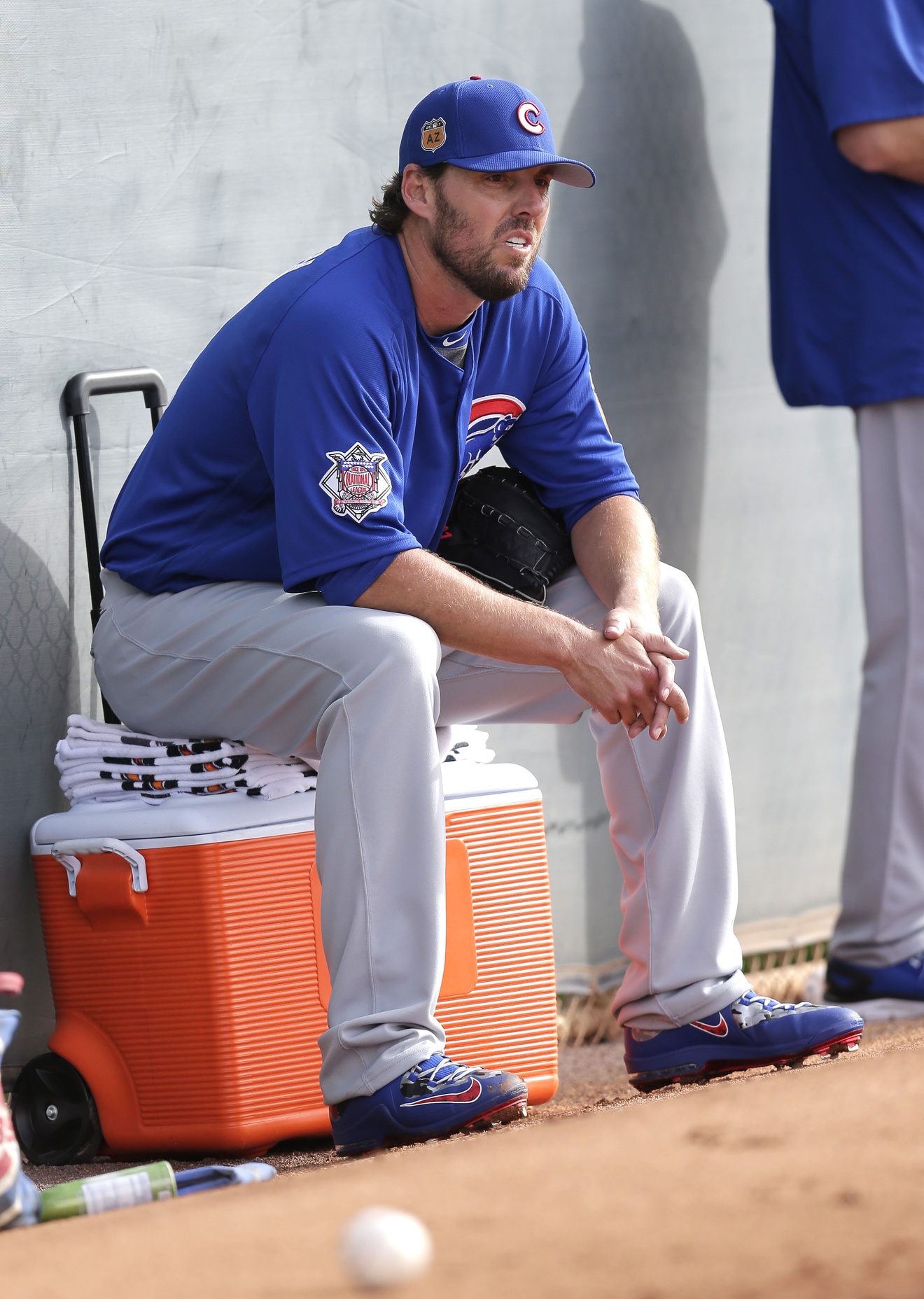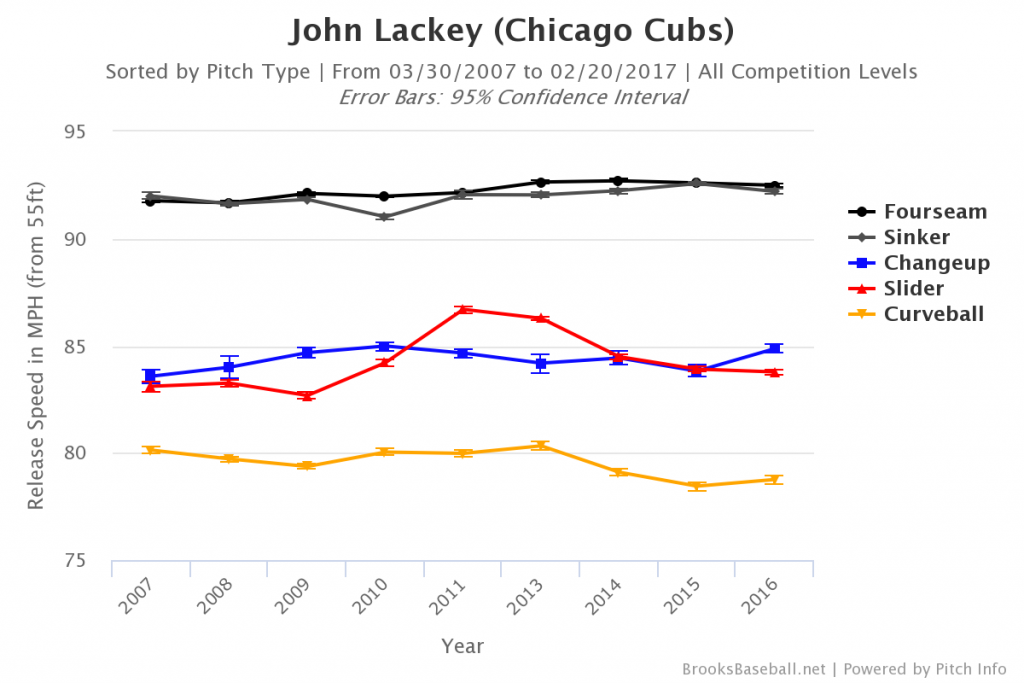John Lackey enters 2017 at 38, after 14 years and almost 2700 innings in the major leagues. The sample of starters who have been pitching at that age, let alone having success, is relatively small. Lackey’s made it there; what then should—or could—we expect from him?
The projections naturally give us a starting point. PECOTA forecasts 194 1/3 innings with a 4.02 ERA and 4.37 DRA, good for 1.8 WARP. Should it happen, that would be Lackey’s worst season since 2011, after which he needed Tommy John surgery. Steamer’s 3.88 ERA over 180 innings is more optimistic, while ZiPS goes as far as a 3.52 ERA, albeit with a step back in the strikeout numbers.
Projections can only get us so far, though: What about the fortunes of other pitchers who have pitched in the majors at 38? The Baseball-Reference Play Index is indispensable for answering such queries. 48 starters have pitched at least 100 innings in their age-38 season in the Expansion Era, just under one per year. Here are the top 10 age-38 seasons by WAR:
| Player | WAR | IP | Yr | Tm | GS | CG | SHO | BB | SO | ERA | FIP | ERA+ | HR | OPS | OPS+ |
|---|---|---|---|---|---|---|---|---|---|---|---|---|---|---|---|
| Randy Johnson | 10.9 | 260 | 2002 | ARI | 35 | 8 | 4 | 71 | 334 | 2.32 | 2.66 | 195 | 26 | 0.619 | 59 |
| Phil Niekro | 8.9 | 330.1 | 1977 | ATL | 43 | 20 | 2 | 164 | 262 | 4.03 | 3.74 | 111 | 26 | 0.712 | 88 |
| Bert Blyleven | 6 | 241 | 1989 | CAL | 33 | 8 | 5 | 44 | 131 | 2.73 | 3.08 | 140 | 14 | 0.623 | 77 |
| Roger Clemens | 5.6 | 220.1 | 2001 | NYY | 33 | 0 | 0 | 72 | 213 | 3.51 | 3.29 | 128 | 19 | 0.683 | 79 |
| Steve Carlton | 5.5 | 283.2 | 1983 | PHI | 37 | 8 | 3 | 84 | 275 | 3.11 | 2.65 | 116 | 20 | 0.672 | 92 |
| John Smoltz | 4.9 | 229.2 | 2005 | ATL | 33 | 3 | 1 | 53 | 169 | 3.06 | 3.27 | 139 | 18 | 0.65 | 73 |
| Al Leiter | 4.8 | 173.2 | 2004 | NYM | 30 | 0 | 0 | 97 | 117 | 3.21 | 4.76 | 133 | 16 | 0.686 | 84 |
| Dennis Martinez | 4.7 | 226.1 | 1992 | MON | 32 | 6 | 0 | 60 | 147 | 2.47 | 3.09 | 141 | 12 | 0.559 | 63 |
| Tim Wakefield | 4.5 | 225.1 | 2005 | BOS | 33 | 3 | 0 | 68 | 151 | 4.15 | 4.75 | 109 | 35 | 0.734 | 90 |
| Kevin Brown | 4.5 | 211 | 2003 | LAD | 32 | 0 | 0 | 56 | 185 | 2.39 | 2.82 | 169 | 11 | 0.608 | 67 |
Not a bad list of names, headed by five Hall of Famers, and also including one guy who by achievements alone is a slam-dunk Hall of Famer, one borderline candidate in Brown, and two others who are at least candidates for the Hall of Very Good. After all, it’s difficult to still be pitching in the major leagues at 38 without having a relatively productive career before that. All of these players had been worth at least 30 wins prior to this season, and Lackey is no different in that regard. He’s been worth 36.9 WAR by Baseball-Reference’s standards, while DRA-based WARP gives him much greater credit, putting him nearly ten wins higher at 46.3 WARP.
Something that’s conspicuously absent from this list is a single season that took place over the last decade. The early-2000s were filled with 38-year-olds having success in the majors, yet none have cracked the top ten since. Let’s take a look at the same age group since 2007.
| Player | WAR | IP | Year | Tm | GS | CG | SHO | BB | SO | ERA | FIP | ERA+ | HR | OPS | OPS+ |
|---|---|---|---|---|---|---|---|---|---|---|---|---|---|---|---|
| Hiroki Kuroda | 4.1 | 201.1 | 2013 | NYY | 32 | 1 | 1 | 43 | 150 | 3.31 | 3.56 | 121 | 20 | 0.683 | 88 |
| A.J. Burnett | 2.7 | 164 | 2015 | PIT | 26 | 0 | 0 | 49 | 143 | 3.18 | 3.36 | 122 | 11 | 0.716 | 103 |
| Andy Pettitte | 2.5 | 129 | 2010 | NYY | 21 | 0 | 0 | 41 | 101 | 3.28 | 3.85 | 132 | 13 | 0.703 | 86 |
| Bartolo Colon | 2.1 | 164.1 | 2011 | NYY | 26 | 1 | 1 | 40 | 135 | 4.00 | 3.83 | 107 | 21 | 0.751 | 99 |
| R.A. Dickey | 2 | 224.2 | 2013 | TOR | 34 | 3 | 1 | 71 | 177 | 4.21 | 4.58 | 98 | 35 | 0.728 | 98 |
| Tim Hudson | 1.5 | 189.1 | 2014 | SFG | 31 | 1 | 0 | 34 | 120 | 3.57 | 3.54 | 97 | 15 | 0.713 | 108 |
| Mike Mussina | 1 | 152 | 2007 | NYY | 27 | 0 | 0 | 35 | 91 | 5.15 | 4.01 | 88 | 14 | 0.814 | 111 |
| Derek Lowe | -1 | 187 | 2011 | ATL | 34 | 0 | 0 | 70 | 137 | 5.05 | 3.70 | 76 | 14 | 0.754 | 111 |
In the last decade, there have only been eight pitchers to start in the majors at 38 and crack 100 innings. Only Kuroda got close to the first group in terms of performance, and only he and Dickey topped 200 innings. There are some useful seasons here, but only Kuroda’s season represents what the Cubs would likely consider an unqualified success out of their fourth starter.
The others either lack the innings, or have rather disappointing lines. Although Chicago has certainly been building the depth to cover a hole in the rotation, if Lackey fell 60-70 innings short of a full workload, it would put a lot more pressure on Brett Anderson’s health and Mike Montgomery’s ability to start.
For some, 38 represented the end of their career as a useful major league starter, although most still went on to pitch at least another year or two. Lowe’s 2011 was actually much better by WARP, as his FIP might imply, but he would be a replacement-level pitcher over the final two years of his career. 38 was also the end of Jack Morris, who was essentially a replacement-level pitcher over his final two seasons.
Lackey doesn’t profile like a lot of these pitchers who struggled at 38 and later. He may well be underrated for how good he’s been, both for his age and over the course of his career. Over his last three seasons, he’s posted a 3.39 K/BB with 7.7 strikeouts per nine and just 2.3 walks per nine. Only six pitchers have ever had a better strikeout:walk ratio at 38; just three of those also had a better K/9. All three – Johnson, Carlton, and Brown – appear in the first table. Lackey’s WARP total ranks 78th all-time amongst pitchers, just two wins behind his teammate, Jon Lester. Another similar season to 2016 would put him close to the top 60, ahead of Chris Carpenter & Cliff Lee, and around Johan Santana.
More encouraging still are the indications that Lackey might actually still be improving. His 2016 strikeout rate and swinging strike rate were the best of his career. There were some suggestions that his velocity was increasing but at the very least, it seems to be holding steady, and certainly did improve following his Tommy John surgery that forced him to miss 2012:
Lackey has even addressed his issues against lefties, something that has plagued him throughout his career. Eno Sarris highlighted the harder changeup, the evidence of which can be seen in the graph, and improvements with his curveball usage as primary reasons for his improvement against opposite-handed hitters. At 37, Lackey was still finding ways to improve his approach. The context doesn’t hurt, either. Nobody reading this is likely to forget the fact that he will still be playing on an exceptional defensive team.
This shouldn’t obscure the fact that Lackey is firmly on the wrong side of the aging curve. Even being in that elite group of age-38 pitchers was no guarantee of ongoing success. For both Carlton and Brown, decline would soon follow. 2003 was Brown’s last good season, while Carlton was merely a four-win player in 1984. Randy Johnson continued to be ridiculous, but comparing any pitcher to someone who was still producing ten-win seasons at 40 is not instructive (it’s really fun to look at Johnson’s player card, though).
One thing that can be said for those who held up at 38 is that they almost universally continued to be major league contributors at 39. Of our original 48 100-plus inning starters, 43 would go on to pitch in the majors in their age 39 season, and 42 of them again went over 100 innings. Two of those players are, of course, still active. Bartolo Colon and R.A. Dickey will suit up for the same team in 2017, both well into their 40s, and both still capable of providing major league quality innings.
Lackey talked of retiring after this two-year deal was up. As a three-time World Series winner with three separate teams, he’s won more than most players ever will, and if the Cubs have another spectacular season, he may decide that this is a better time to go out than any. Should Lackey decide to keep pitching at least one more year, there’s plenty of evidence to suggest that there’s more success waiting as he approaches 40.
Lead photo courtesy Rick Scuteri—USA Today Sports


Very helpful write up. Lackey is the biggest pitching question I personally have this year – even more so than Montgomery or Anderson. It would be interesting to see if others his age had a similar fall off toward the end of the season as he did last year.
Thanks – that’s a good question, I will follow up on that!